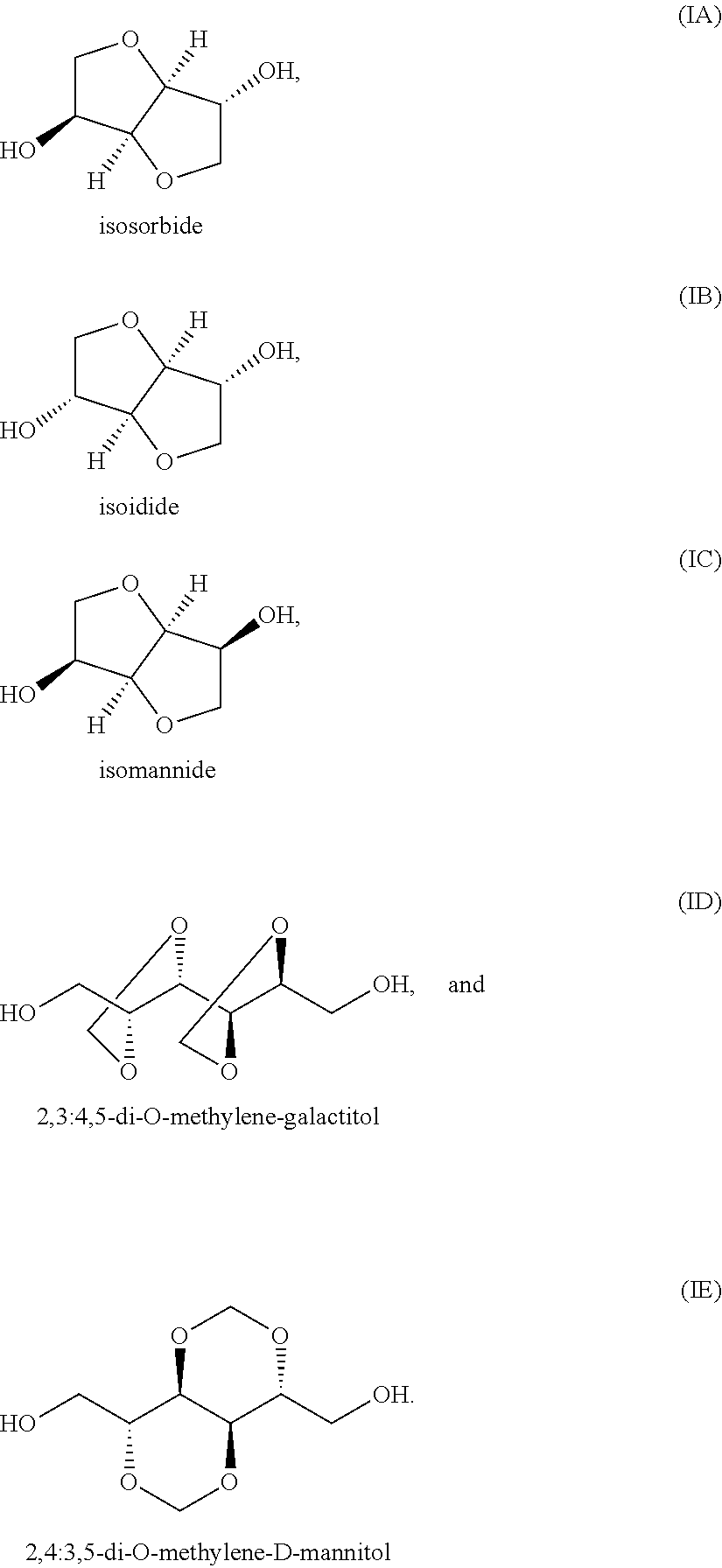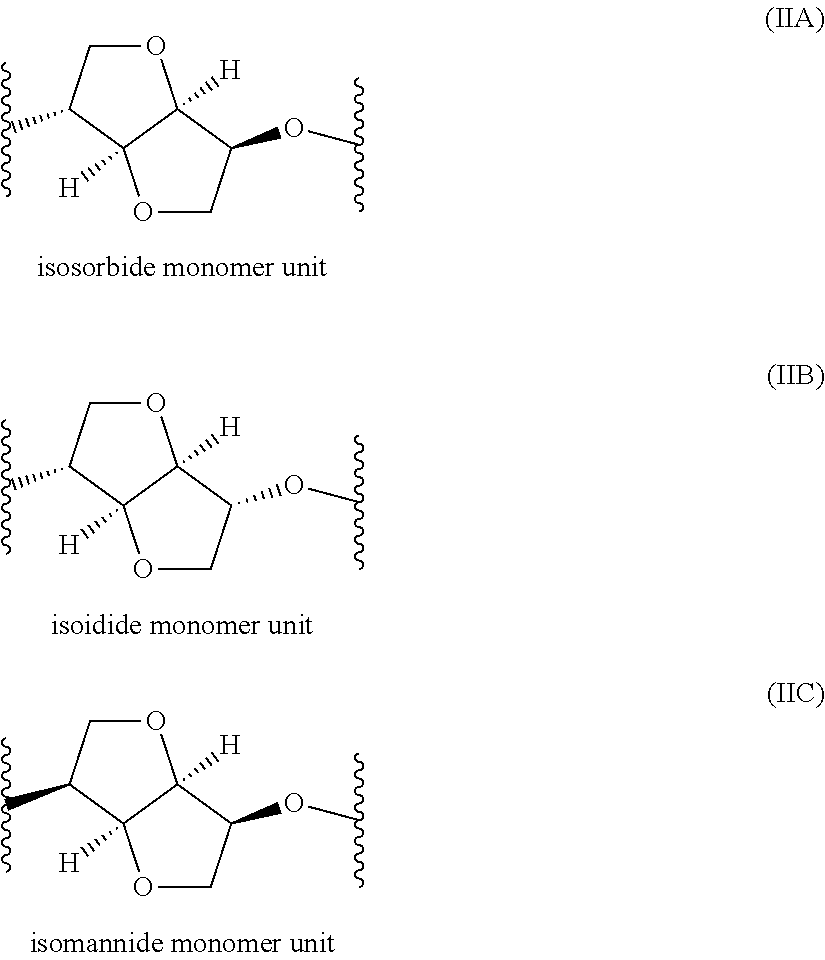Polyester Copolymer
a polymer and copolymer technology, applied in the field of polymer copolymer, can solve the problems of increasing global greenhouse gas emissions, increasing the cost of bio-based terephthalic acid or bio-based terephthalic acid ester, and increasing the cost of bio-based terephthalic acid production, etc., to achieve the effect of improving (bio-) degradability and commercially interesting oxygen-permeation degr
- Summary
- Abstract
- Description
- Claims
- Application Information
AI Technical Summary
Benefits of technology
Problems solved by technology
Method used
Image
Examples
example 4
on of Poly(Isosorbide / Butylene Oxalate) Polyester Copolymer by Polymerization of Diphenyl Oxalate, Isosorbide and Butanediol-1,4
[0210]Example 4 was carried out as example 1, except that 12.47 g of isosorbide (to be abbreviated as ISO hereinafter, 85.31 mmol), 25.50 g of diphenyl oxalate (to be abbreviated as DPO hereinafter, 105.31 mmol), 1.80 g of butanediol-1,4 (to be abbreviated as BDO hereinafter, 19.96 mmol), 8.3 mg of Irganox 1010 and 9.2 mg Hostanox PEPQ were weighted into the 100 mL glass reactor. In the polycondensation stage the pressure was reduced to lower than 1 mbar over 1.5 hours instead of over 2 hours. The resulting poly(isosorbide / butylene oxalate) polyester copolymer contained 8.7 mole % butanediol monomer units in the polyester copolymer, and had a Tg, Mw, Mn and polydispersity index as indicated in Table I.
example 5
on of Poly(Isosorbide / Butylene Oxalate) Polyester Copolymer by Polymerization of Diphenyl Oxalate, Isosorbide and Butanediol-1,4
[0211]Example 5 was carried out as comparative example 1, except that 7.68 g of isosorbide (to be abbreviated as ISO hereinafter, 52.51 mmol), 25.82 g of diphenyl oxalate (to be abbreviated as DPO hereinafter, 106.61 mmol), 4.85 g of butanediol-1,4 (to be abbreviated as BDO hereinafter, 53.80 mmol), 9.4 mg of Irganox 1010 and 12.1 mg Hostanox PEPQ were weighted into the 100 mL glass reactor.
[0212]In the polycondensation stage the pressure was reduced to lower than 5 mbar (instead of the 1 mbar mentioned in example 1) over 1.5 hours. The resulting poly(isosorbide / butylene oxalate) polyester copolymer contained 23.7 mole % butanediol monomer units in the polyester copolymer and had a Tg, Mw, Mn and polydispersity index as indicated in Table I.
example 6
on of Poly(Isosorbide / Butylene Oxalate) Polyester Copolymer by Polymerization of Diphenyl Oxalate, Isosorbide and Butanediol-1,4
[0213]Example 6 was carried out as example 5, except that 10.50 g of isosorbide (to be abbreviated as ISO hereinafter, 71.81 mmol), 25.49 g of diphenyl oxalate (to be abbreviated as DPO hereinafter, 105.23 mmol), 2.94 g of butanediol-1,4 (to be abbreviated as BDO hereinafter, 32.65 mmol), 9.1 mg of Irganox 1010 and 9.8 mg Hostanox PEPQ were weighted into the 100 mL glass reactor. The resulting poly(isosorbide / butylene oxalate) polyester copolymer contained 13.8 mole % butanediol monomer units in the polyester copolymer and had a Tg, Mw, Mn and polydispersity index as indicated in Table I.
PUM
| Property | Measurement | Unit |
|---|---|---|
| glass transition temperature | aaaaa | aaaaa |
| molar ratio | aaaaa | aaaaa |
| glass transition temperature | aaaaa | aaaaa |
Abstract
Description
Claims
Application Information
 Login to View More
Login to View More - R&D
- Intellectual Property
- Life Sciences
- Materials
- Tech Scout
- Unparalleled Data Quality
- Higher Quality Content
- 60% Fewer Hallucinations
Browse by: Latest US Patents, China's latest patents, Technical Efficacy Thesaurus, Application Domain, Technology Topic, Popular Technical Reports.
© 2025 PatSnap. All rights reserved.Legal|Privacy policy|Modern Slavery Act Transparency Statement|Sitemap|About US| Contact US: help@patsnap.com



